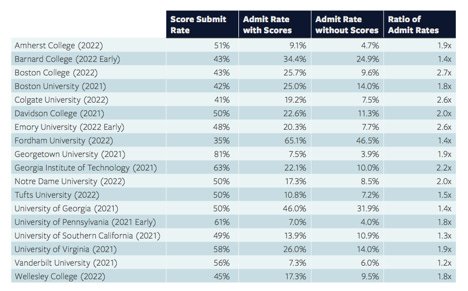Columbia goes test-optional
Columbia and William and Mary have announced permanent test-optional policies; they will not require standardized test scores for undergraduate admission. Many colleges had temporary test-optional policies in place during the pandemic, when standardized test availability was spotty. These two schools and others have decided to adopt that approach, whereby applicants can but are not required to submit test scores, for good.
(Test-blind policies, like the UC system has, are a different story. The UCs won’t look at your test scores even if you submit them. We’re not talking about those in this post.)
So, should your kid take a standardized test? Yes.
I think test-optional policies are a smokescreen. They allow colleges to look DEI-concerned while still doing whatever they want. And what do they do? They let in applicants who do submit test scores at higher rates.
Here’s a table from one of the two test prep services I recommend, Compass. Sorry it’s so tiny. Squarespace has a pretty bad blog situation.
Zoom in to see that the admission rate for score-submitters vs. not is more than double at some schools!
What about Columbia and William and Mary, the colleges that just became permanently test-optional?
Both colleges issued press releases with a lot of nonsense buzzword salad about holistic considerations, flexibility, valuing the whole student experience, etc. That’s what they claim to do.
What do they really do? I don’t have the admission rates for score-submitters vs. not for those two colleges, but we can infer a bit from what the colleges publish in their Common Datasets. In 2021, the most recent data available, 73 percent and 70 percent of freshmen enrolled at Columbia and William and Mary, respectively, had submitted test scores.
So, what do Columbia and William and Mary actually do? They let in a lot of kids who submit test scores.
Your kid should take a standardized test. Let’s talk about how to prepare most effectively and least painfully. You can book a one-on-one consultation here or take the online course.

